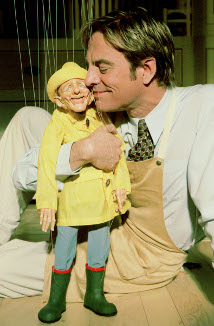Canadian Theatre Encyclopedia
Happy

The third marionette play in Ronnie Burkett’s Memory Dress Trilogy, which also includes Tinka’s New Dress and Street of Blood. Happy premiered in April, 2000 at the DuMaurier World Stage Festival. It was also performed at Usine C (Montreal), and Festival Theaterformen 2000 in Germany as part of Expo 2000. For the Theatre Network production in 2000 it was awarded Sterling Awards for Best Play and Best Actor. In June, 2001, it played at the Barbican Centre in London, England to positive reviews.
Happy is the least complex of the three plays in the trilogy in narrative structure and in historical setting, but just as ingenious in its puppetry. Burkett is again on stage with his miniature creations, pulling the strings and voicing all the parts, in effect assuming the role of a personalised fate, as he takes in his hands the destinies of each character.
The set is a large four-sided structure that rotates to show a cupboard with drawers and shelves, a miniature house, and a cabaret stage.
The action is located in and around a rooming-house occupied by a young couple, Carla and Drew, a gay couple, a kindly old man, and a querulous old woman. Their past and present lives occasion philosophical speculation on the nature and possibility of “happiness.” Happy is choric character who links past and present, providing an historical and philosophical perspective, and a welcome humorous relief to a play which tracks the five stages of grief after the death of a loved one. Inexplicably, it is Drew, the happy-go-lucky young hippy, who dies just after persuading Carla to make love, and Carla’s response which provides the narrative centre for the ensuing two hours. A grotesque Commedia figure introduces each of her five steps of grieving – from denial to acceptance - and song and dance routines by five other grotesque (and parodic) entertainers comically illustrate these emotional responses; for example, “Miss Cleo Pain” sings the Blues, and a Pierrette struggles to place a cello between her legs. The stories of the other occupants of the house occasion explorations of such divergent scenarios as the tribulations of the gay life in Moosejaw, and the traumatic discovery of concentration camp skeletal survivors at the end of World War II. Each episode occasions an ingenious display of puppetry, although the narrative line is tenuous.
The philosophical gloom is alleviated through the scatological stories and antics of Happy, and his comic reflections on growing old. His “nude scene” in the tub provides a wholly different dimension to the possibilities of puppetry. Although he also succumbs to sentimentalism near the end of the play, when he recounts the story of his own young son’s death, his philosophy of life as a rainbow of colour, and his final appearance in a vibrant yellow raincoat, swinging joyously in a park, in the rain, on his own, provides a delightful conclusion to the play.
Burkett solicits audience response through topical references and improvisation, occasionally deviating from the story to engage in political or local humour.
Commentary by Anne Nothof, Athabasca University
Last updated 2018-03-07

